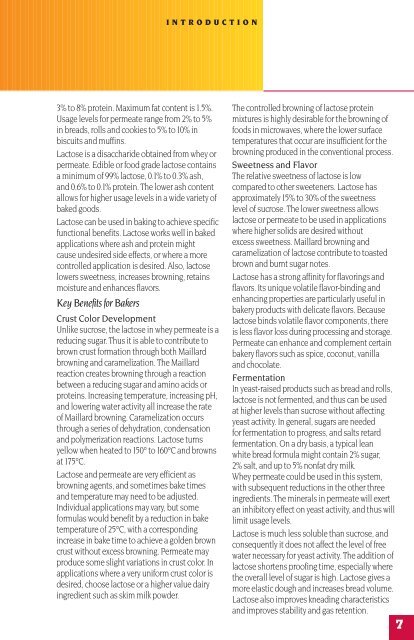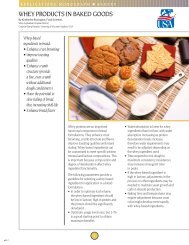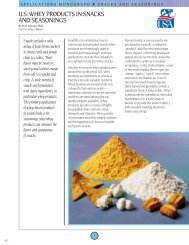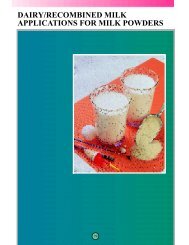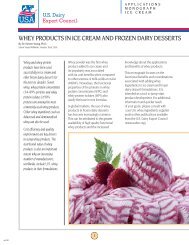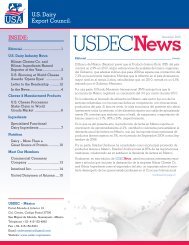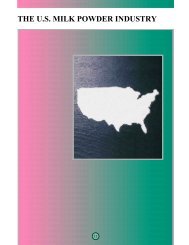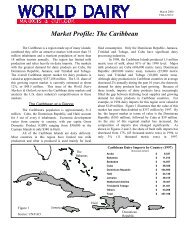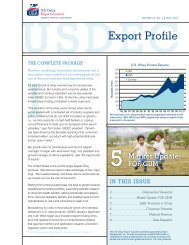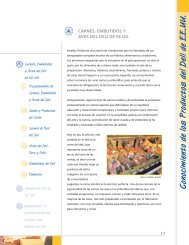USDEC Bakery recipes
USDEC Bakery recipes
USDEC Bakery recipes
- No tags were found...
Create successful ePaper yourself
Turn your PDF publications into a flip-book with our unique Google optimized e-Paper software.
INTRODUCTION3% to 8% protein. Maximum fat content is1.5%.Usage levels for permeate range from 2% to 5%in breads, rolls and cookies to 5% to10% inbiscuits and muffins.Lactose is a disaccharide obtained from whey orpermeate. Edible or food grade lactose containsa minimum of 99% lactose, 0.1% to 0.3% ash,and 0.6% to 0.1% protein. The lower ash contentallows for higher usage levels in a wide variety ofbaked goods.Lactose can be used in baking to achieve specificfunctional benefits. Lactose works well in bakedapplications where ash and protein mightcause undesired side effects, or where a morecontrolled application is desired. Also, lactoselowers sweetness, increases browning, retainsmoisture and enhances flavors.Key Benefits for BakersCrust Color DevelopmentUnlike sucrose, the lactose in whey permeate is areducing sugar. Thus it is able to contribute tobrown crust formation through both Maillardbrowning and caramelization. The Maillardreaction creates browning through a reactionbetween a reducing sugar and amino acids orproteins. Increasing temperature, increasing pH,and lowering water activity all increase the rateof Maillard browning. Caramelization occursthrough a series of dehydration, condensationand polymerization reactions. Lactose turnsyellow when heated to150° to160°C and brownsat175°C.Lactose and permeate are very efficient asbrowning agents, and sometimes bake timesand temperature may need to be adjusted.Individual applications may vary, but someformulas would benefit by a reduction in baketemperature of 25°C, with a correspondingincrease in bake time to achieve a golden browncrust without excess browning. Permeate mayproduce some slight variations in crust color. Inapplications where a very uniform crust color isdesired, choose lactose or a higher value dairyingredient such as skim milk powder.The controlled browning of lactose proteinmixtures is highly desirable for the browning offoods in microwaves, where the lower surfacetemperatures that occur are insufficient for thebrowning produced in the conventional process.Sweetness and FlavorThe relative sweetness of lactose is lowcompared to other sweeteners. Lactose hasapproximately15% to 30% of the sweetnesslevel of sucrose. The lower sweetness allowslactose or permeate to be used in applicationswhere higher solids are desired withoutexcess sweetness. Maillard browning andcaramelization of lactose contribute to toastedbrown and burnt sugar notes.Lactose has a strong affinity for flavorings andflavors. Its unique volatile flavor-binding andenhancing properties are particularly useful inbakery products with delicate flavors. Becauselactose binds volatile flavor components, thereis less flavor loss during processing and storage.Permeate can enhance and complement certainbakery flavors such as spice, coconut, vanillaand chocolate.FermentationIn yeast-raised products such as bread and rolls,lactose is not fermented, and thus can be usedat higher levels than sucrose without affectingyeast activity. In general, sugars are neededfor fermentation to progress, and salts retardfermentation. On a dry basis, a typical leanwhite bread formula might contain 2% sugar,2% salt, and up to 5% nonfat dry milk.Whey permeate could be used in this system,with subsequent reductions in the other threeingredients. The minerals in permeate will exertan inhibitory effect on yeast activity, and thus willlimit usage levels.Lactose is much less soluble than sucrose, andconsequently it does not affect the level of freewater necessary for yeast activity. The addition oflactose shortens proofing time, especially wherethe overall level of sugar is high. Lactose gives amore elastic dough and increases bread volume.Lactose also improves kneading characteristicsand improves stability and gas retention.7


